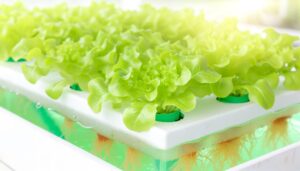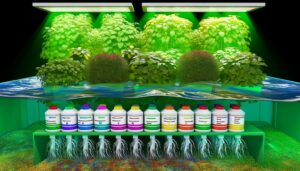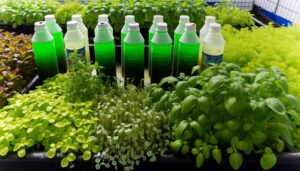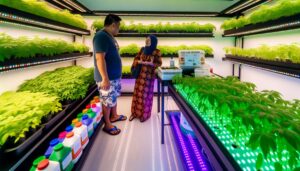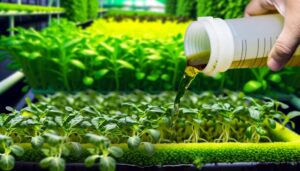Hydroponic Nutrient Solution for Strawberries
A hydroponic nutrient solution for strawberries must balance macronutrients such as Nitrogen (150-200 ppm), Phosphorus (50-70 ppm), and Potassium (200-250 ppm) to promote vegetative growth and fruit quality. Secondary nutrients like Calcium, Magnesium, and Sulfur support cell wall integrity and chlorophyll production.
Micronutrients including Iron, Zinc, and Boron are vital for enzymatic functions. Maintaining an ideal pH range of 5.8 to 6.2 is essential for nutrient availability.
Regular nutrient monitoring and pH adjustments are important to prevent deficiencies and promote vigorous growth. Understanding these principles can maximize your hydroponic strawberry yield.
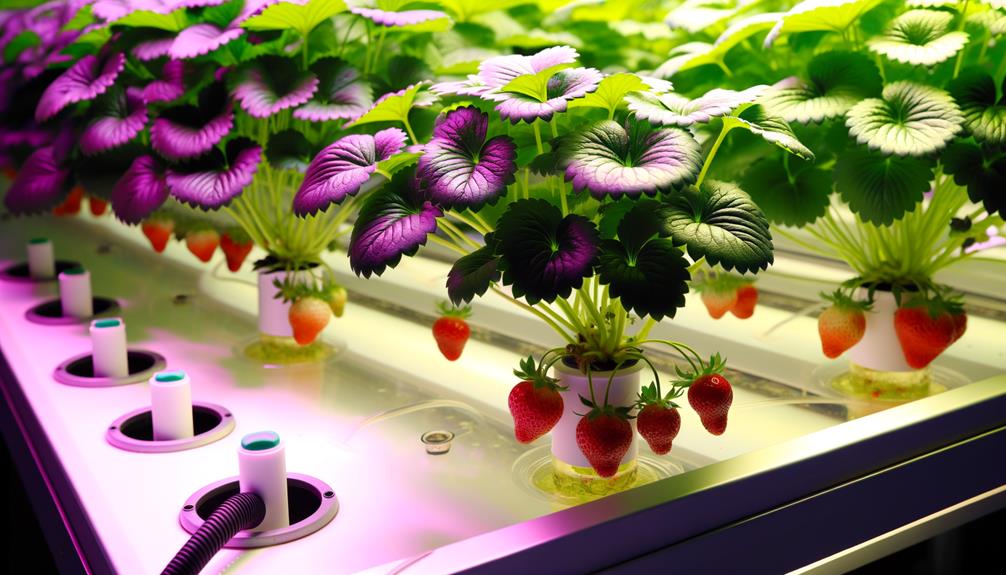
Key Takeaways
- Ensure an optimal pH range of 5.8-6.2 for maximum nutrient availability and plant health.
- Maintain nutrient ratios: Nitrogen 150-200 ppm, Phosphorus 50-70 ppm, and Potassium 200-250 ppm for robust growth.
- Monitor nutrient solution's electrical conductivity (EC) to stay between 1.5-2.5 mS/cm for balanced nutrient uptake.
- Include essential secondary nutrients and micronutrients to support cell wall integrity, chlorophyll production, and enzymatic activities.
Essential Nutrients for Strawberries
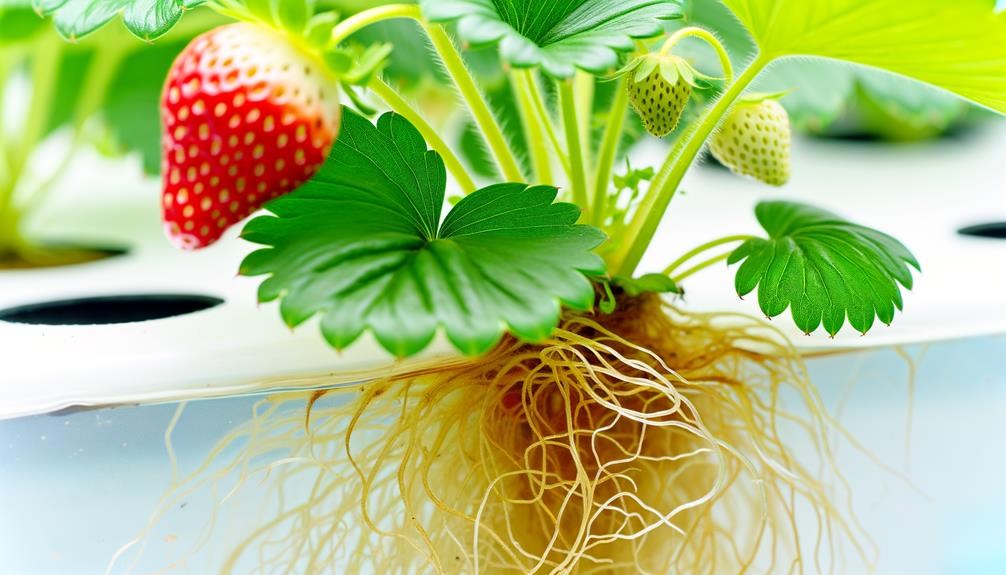
Strawberries require a balanced supply of 16 essential nutrients to achieve ideal growth and fruit production in a hydroponic system.
These nutrients are categorized into macronutrients, secondary nutrients, and micronutrients.
Macronutrients include nitrogen (N), phosphorus (P), and potassium (K), which are fundamental for vegetative growth, root development, and fruit quality.
Secondary nutrients, such as calcium (Ca), magnesium (Mg), and sulfur (S), play significant roles in cell wall integrity, chlorophyll production, and protein synthesis.
Micronutrients, including iron (Fe), manganese (Mn), zinc (Zn), copper (Cu), molybdenum (Mo), boron (B), chlorine (Cl), and nickel (Ni), are required in trace amounts but are essential for enzymatic activities, hormone regulation, and overall plant health.
Ensuring a precise nutrient formulation is key for ideal strawberry cultivation in hydroponics.
Optimal Nutrient Ratios
Achieving ideal nutrient ratios in a hydroponic system is critical for maximizing the growth, health, and yield of strawberry plants. Essential macronutrients such as Nitrogen (N), Phosphorus (P), and Potassium (K) need to be supplied in suitable concentrations to guarantee robust plant development. According to research, the recommended ratios for these nutrients are as follows:
| Nutrient | Suitable Ratio | Function in Plant Growth |
|---|---|---|
| Nitrogen (N) | 150-200 ppm | Promotes leaf and stem growth |
| Phosphorus (P) | 50-70 ppm | Supports root and flower development |
| Potassium (K) | 200-250 ppm | Enhances fruit quality and disease resistance |
Balancing these nutrients effectively enhances photosynthesis, nutrient uptake, and overall plant vigor, leading to higher fruit yield and quality.
Maintaining Proper Ph Levels
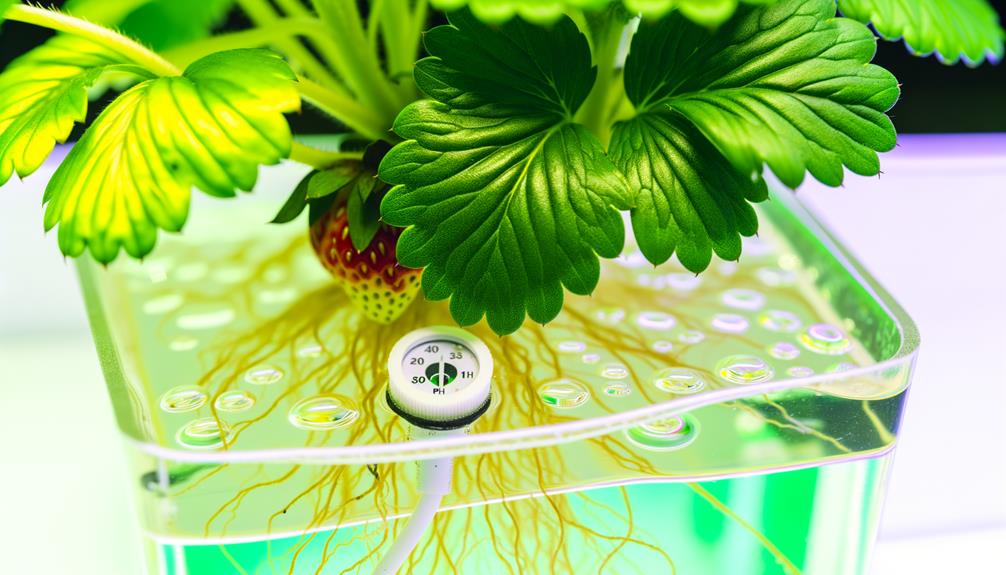
Maintaining the proper pH levels in a hydroponic system is critical for maximizing nutrient availability and ensuring the health and productivity of strawberry plants.
The ideal pH range for hydroponic strawberries is between 5.8 and 6.2. Within this range, essential nutrients such as nitrogen, phosphorus, and potassium are most accessible to the plants. Deviations from this range can lead to nutrient lockout, where certain elements become insoluble and unavailable for uptake.
Regular monitoring using a reliable pH meter is essential. Adjustments can be made using pH up or pH down solutions to stabilize the levels.
Consistent pH management not only prevents nutrient deficiencies but also fosters an excellent growth environment, promoting vigorous plant development and high fruit yield.
Troubleshooting Common Issues
Despite meticulous pH management, hydroponic strawberry growers may still encounter common issues such as nutrient deficiencies, root rot, and pest infestations.
Nutrient deficiencies often manifest as chlorosis or necrosis in leaves, indicating a lack of essential elements like nitrogen, potassium, or magnesium.
Root rot, usually caused by pathogens like Pythium or Phytophthora, can be identified by brown, mushy roots and stunted plant growth. Effective sanitation and maintaining ideal oxygen levels in the nutrient solution can mitigate this issue.
Pest infestations, including aphids, spider mites, and whiteflies, necessitate regular monitoring and the use of integrated pest management (IPM) strategies.
Addressing these challenges promptly is vital to maintaining plant health and ensuring a successful hydroponic strawberry crop.
Tips for Maximizing Yield
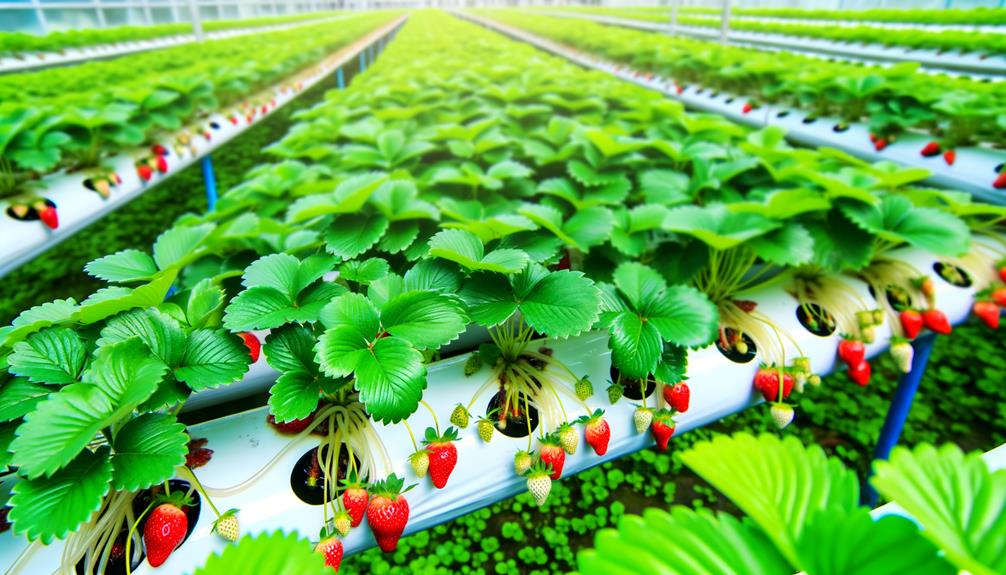
Optimizing yield in hydroponic strawberry cultivation necessitates precise control over environmental factors, nutrient formulations, and plant management techniques.
Maintaining an ideal temperature range of 18-24°C and relative humidity between 60-70% is essential. Light intensity should be managed to provide 14-16 hours of light daily.
Employing a balanced nutrient solution with an electrical conductivity (EC) of 1.5-2.5 mS/cm and pH of 5.8-6.2 guarantees adequate nutrient uptake. Regular monitoring and adjustments are imperative to prevent nutrient imbalances.
Pruning old leaves and runners enhances air circulation and energy allocation to fruit production. Additionally, integrating integrated pest management (IPM) strategies minimizes pest and disease impact.
Adhering to these guidelines will greatly enhance yield and fruit quality.
Conclusion
In summary, the formulation and maintenance of an ideal hydroponic nutrient solution are vital for maximizing strawberry yield. This requires careful monitoring of nutrient concentrations, pH levels, and water quality to ensure optimal plant health. Implementing stepbystep hydroponic fertilization helps provide strawberries with the essential nutrients they need at different growth stages. Proper nutrient management not only enhances fruit production but also improves the flavor and overall quality of the harvest.
Essential nutrients include nitrogen, phosphorus, potassium, calcium, and magnesium, with a recommended pH level between 5.5 and 6.0.
An interesting statistic highlights that hydroponically grown strawberries can yield up to 30% more fruit compared to traditional soil cultivation.
By closely monitoring nutrient ratios and pH levels, growers can greatly enhance both the quantity and quality of strawberry production.

